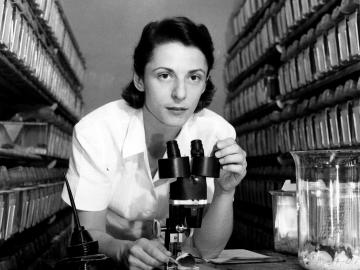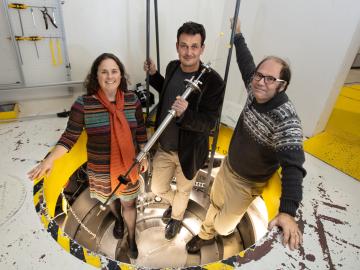
Filter News
Area of Research
- Advanced Manufacturing (5)
- Biological Systems (1)
- Biology and Environment (32)
- Computational Biology (2)
- Computational Engineering (2)
- Energy Science (34)
- Fuel Cycle Science and Technology (1)
- Fusion and Fission (29)
- Fusion Energy (10)
- Isotope Development and Production (1)
- Isotopes (12)
- Materials (58)
- Materials for Computing (8)
- Mathematics (1)
- National Security (10)
- Neutron Science (121)
- Nuclear Science and Technology (40)
- Nuclear Systems Modeling, Simulation and Validation (1)
- Supercomputing (33)
News Type
News Topics
- (-) Biomedical (72)
- (-) Clean Water (33)
- (-) Molten Salt (10)
- (-) Neutron Science (166)
- (-) Nuclear Energy (118)
- (-) Space Exploration (26)
- 3-D Printing/Advanced Manufacturing (141)
- Advanced Reactors (38)
- Artificial Intelligence (129)
- Big Data (75)
- Bioenergy (111)
- Biology (128)
- Biotechnology (39)
- Buildings (70)
- Chemical Sciences (85)
- Composites (34)
- Computer Science (222)
- Coronavirus (48)
- Critical Materials (29)
- Cybersecurity (34)
- Education (5)
- Element Discovery (1)
- Emergency (4)
- Energy Storage (112)
- Environment (210)
- Exascale Computing (65)
- Fossil Energy (8)
- Frontier (62)
- Fusion (65)
- Grid (72)
- High-Performance Computing (126)
- Hydropower (12)
- Irradiation (2)
- Isotopes (60)
- ITER (9)
- Machine Learning (67)
- Materials (149)
- Materials Science (154)
- Mathematics (12)
- Mercury (12)
- Microelectronics (4)
- Microscopy (55)
- Nanotechnology (62)
- National Security (84)
- Partnerships (68)
- Physics (69)
- Polymers (34)
- Quantum Computing (52)
- Quantum Science (91)
- Security (31)
- Simulation (63)
- Software (1)
- Statistics (4)
- Summit (70)
- Transportation (97)
Media Contacts

OAK RIDGE, Tenn., Feb. 19, 2020 — The U.S. Department of Energy’s Oak Ridge National Laboratory and the Tennessee Valley Authority have signed a memorandum of understanding to evaluate a new generation of flexible, cost-effective advanced nuclear reactors.

As the second-leading cause of death in the United States, cancer is a public health crisis that afflicts nearly one in two people during their lifetime.

Oak Ridge National Laboratory will partner with Cincinnati Children’s Hospital Medical Center to explore ways to deploy expertise in health data science that could more quickly identify patients’ mental health risk factors and aid in

Researchers have developed a new process that could make it much cheaper to produce biofuels such as ethanol from plant waste and reduce reliance on fossil fuels.

A select group gathered on the morning of Dec. 20 at the Department of Energy’s Oak Ridge National Laboratory for a symposium in honor of Liane B. Russell, the renowned ORNL mammalian geneticist who died in July.

Illustration of the optimized zeolite catalyst, or NbAlS-1, which enables a highly efficient chemical reaction to create butene, a renewable source of energy, without expending high amounts of energy for the conversion. Credit: Jill Hemman, Oak Ridge National Laboratory/U.S. Dept. of Energy

While Tsouris’ water research is diverse in scope, its fundamentals are based on basic science principles that remain largely unchanged, particularly in a mature field like chemical engineering.

As scientists study approaches to best sustain a fusion reactor, a team led by Oak Ridge National Laboratory investigated injecting shattered argon pellets into a super-hot plasma, when needed, to protect the reactor’s interior wall from high-energy runaway electrons.

An international team of scientists, led by the University of Manchester, has developed a metal-organic framework, or MOF, material

Scientists at the U.S. Department of Energy’s Brookhaven National Laboratory have new experimental evidence and a predictive theory that solves a long-standing materials science mystery: why certain crystalline materials shrink when heated.


